
'Over Here,' Athletes Gave to WWI Effort
March 28, 2018
By Ron Pesch
Special for Second Half
In a nation at war, the needs of many outweigh the desires of a few.
Among the many noble sacrifices for the greater good was Michigan’s spring high school sports season of 1918.
The United States’ entry into “The Great War” (today commonly known as World War I) came on April 6, 1917, 2½ years after the war had begun. First elected President of the United States in 1912, Woodrow Wilson earned re-election in 1916 under a platform to keep the U.S. out of the war in Europe. The sinking of the British passenger ships Arabic and Lusitania in 1915 caused the death of 131 America citizens, but did not invoke entry into the conflict. However, continued aggressive German actions forced a reversal in policy.
“The present German submarine warfare against commerce is a warfare against mankind,” stated Wilson in an April 2 special session of Congress, in requesting action to enter the war.
A huge baseball fan, President Wilson recognized the value of entertainment and athletics during a time of crisis. Major league baseball, America’s pastime, completed a full schedule in 1917. A former president at Princeton University, on May 21, 1917, Wilson addressed the value of school athletics in a letter to the New York Evening Post.
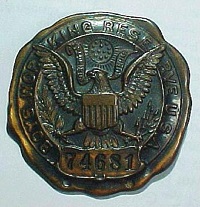 “I would be sincerely sorry to see the men and boys in our colleges and schools give up their athletic sports and I hope most sincerely that the normal courses of college sports will be continued so far as possible, not only to afford a diversion to the American people in the days to come when we shall no doubt have our share of mental depression, but as a real contribution to the national defense. Our young men must be made physically fit in order that later they may take the place of those who are now of military age and exhibit the vigor and alertness which we are proud to believe to be characteristic of our young men.”
“I would be sincerely sorry to see the men and boys in our colleges and schools give up their athletic sports and I hope most sincerely that the normal courses of college sports will be continued so far as possible, not only to afford a diversion to the American people in the days to come when we shall no doubt have our share of mental depression, but as a real contribution to the national defense. Our young men must be made physically fit in order that later they may take the place of those who are now of military age and exhibit the vigor and alertness which we are proud to believe to be characteristic of our young men.”
Despite the highest of hopes, the requirements and realities of war deeply impacted life in the U.S. soon after.
In February of 1918, a proposal was circulated by Dr. John Remsen Bishop, principal of Detroit Eastern High School and president of the Michigan Interscholastic Athletic Association, to abolish spring athletics at Michigan high schools. Due to a labor shortage brought on by the war, the states, including Michigan, needed help on farms, harvesting crops from spring until late fall. The action might also affect the football season of 1918.
The Boys’ Working Reserve, a branch of the U.S. Department of Labor, was organized in the spring of 1917 and designed to tap into an underutilized resource to help address that labor deficiency. “Its object was the organization of the boy-power of the nation for work on the farms during the school vacation months.”
While the idea was popular among schools around Detroit, due to the lack of public commentary from outstate school administration, it was expected that the proposal would meet at least some opposition when the M.I.A.A. gathered on Thursday, March 28 in Ann Arbor during a meeting of the state’s Schoolmasters Club.
Less than two weeks prior to the March meeting, Michigan Agricultural College made an announcement that would impact one aspect of the coming spring sports season.
“The department of athletics of the Michigan Agricultural College begs to inform the high schools of the state that plans for the annual interscholastic track meet, which was to have been conducted here in June, have been given up this year – not through any desire on the part of this department to discourage athletics, but because this is a time when we can and should devote our resources to better uses,” said coach Chester L. Brewer of the Aggies to the Lansing State Journal. “It would hardly be sound judgment for us to make our usual elaborate plans for this meet while our government is appealing to all of us to economize and exercise the utmost thrift. Neither is it wise policy to encourage unnecessary traveling upon the railroads, or to ask high schools of the state to make any expenditures other than those which are absolutely necessary.”
Earlier in the year, similar news had come from the University of Michigan.
In January of 1917, the University of Michigan had announced plans for an elaborate annual high school basketball invitational, designed to identify a Class A state champion. Billed as the “First Annual Interscholastic Basket Ball Tournament,” the March event hosted 38 teams. However, influenced by the war, a decision had been made not to run a second tournament in 1918. Instead, on March 27, Kalamazoo Central and Detroit Central, two of the state’s top teams, were invited to Ann Arbor for a hastily arranged contest at U-M’s Waterman Gymnasium. The schools had split a two-game series during the regular season. Kalamazoo won the season’s third matchup, and while not official, declared itself 1918 Michigan state champion.
Into this environment of patriotism and uncertainty, school administrators arrived in Ann Arbor for the Schoolmasters gathering. There, in the morning, the membership heard a presentation from H. W. Wells, assistant and first director of the Boys’ Working Reserve. “The heart of the nation, rather than the hearts of the nation, is beginning to beat. War is making us a unit,” said Wells, discussing the aim to recruit boys between the ages of 16 and 21 to help provide food for the allies in Europe and at home in the United States.
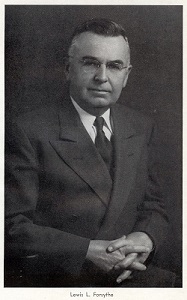 “Wells told of the need for the farmers to sow more wheat, and plant more corn,” reported the Ann Arbor News, “and in the same breath he told of great corn fields all over the country, where last year’s corn still lay unhusked, because of a lack of farm labor.”
“Wells told of the need for the farmers to sow more wheat, and plant more corn,” reported the Ann Arbor News, “and in the same breath he told of great corn fields all over the country, where last year’s corn still lay unhusked, because of a lack of farm labor.”
It was estimated that 25 percent of the nation’s farm workforce was now active in the armed forces.
The proposition was brought to the M.I.A.A. by Lewis L. Forsythe, principal at Ann Arbor High School, who would soon establish himself as a guiding force in high school athletics. The proposal “was discussed thoroughly.”
“This session is usually a stormy one, because of contentions that arise over rulings that affect schools in different ways,” said Adrian superintendent Carl H. Griffey to the Adrian Daily Telegram, “but this meeting was a serious one in which all matters were related to our national welfare and passed by unanimous votes.”
So, one day after the conclusion of the abbreviated state basketball championship contest, the spring prep sports season in Michigan came to an abrupt halt. Michigan’s male high school students were asked to work to support the war effort.
“Chances are that they will remain there for the duration of the war,” stated the Lansing State Journal in response to the action. “At the meeting … it was talked of quitting football because of the need of the boys staying on the farms till the latter part of November. This is highly probable. If it is passed upon then Michigan high schools will have but one sport, basketball.
“Whether intra-mural sports will replace the representative teams is not known. This form of athletics demands the attention of a great number of teachers to tutor the different class organizations. The teachers are taxed to the limit at present and cannot give the time to sports. Organizing farm classes and Liberty bond teams is taking the teacher’s spare moments. … But still athletics are needed, as the war has demonstrated, and physical training should be instituted from the kindergarten to the university.“
“Those lads who leave for the farms the first of May,” wrote the Port Huron Times-Herald, “will be in better condition when they return home from the fields and cow lanes than they would (have) had they remained in the city until June batting the leather pill.”
The fate of the 1918 football season would not be known until late August.
In late June, the 29th Governor of Michigan, Albert E. Sleeper, thanked the estimated 8,000 students who had joined the ranks.
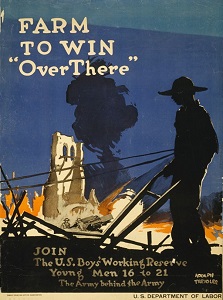 “To you soldiers of the soil I would say this, that I am as proud to address you as I would be to address any of the boys who are bearing arms for their country. You have proved that you are true patriots, for you have started out to do exactly what your country has asked you to do – the thing which you can do best for your country at this time.
“To you soldiers of the soil I would say this, that I am as proud to address you as I would be to address any of the boys who are bearing arms for their country. You have proved that you are true patriots, for you have started out to do exactly what your country has asked you to do – the thing which you can do best for your country at this time.
“Every day, in the rush of official work, I think of you Reservists as you work on the farms, just as I think of our soldiers who are in training camps or ‘over there.’ And I am just as proud of you as I am of them. So are all the people of Michigan.”
It was estimated “the boys who last spring left their high school studies and as members of the United States Boys’ Reserve have helped the Michigan division to add $7,000,000 to the food production of the nation.”
In September, Byron J. Rivett, secretary of the M.I.A.A., announced that, based on a vote of member high schools, prep sports would be resumed in the fall. The Detroit News celebrated the news that “moleskins and pigskins will be in evidence and the grand old game will be a part of the autumn’s entertainment.”
In October, in Grand Rapids and Detroit and other cities across the state, officials gathered to honor those who served as part of the “Michigan Division of the Reserve” and to award bronze badges in recognition for their contribution to the war effort.
World War I officially ended on November 11 with the signing of the armistice. Armistice Day, today known as Veteran’s Day, was first celebrated in 1919. In total, an estimated 16 million were killed during the war.
“Four million ‘Doughboys’ had served in the United States Army with the American Expeditionary Forces (AEF). Half of those participated overseas,” said Mitchell Yockelson in Prologue magazine, a publication of the National Archive. “Although the United States participated in the conflict for less than two years, it was a costly event. More than 100,000 Americans lost their lives during this period.”
More than 5,000 of those casualties had come from Michigan.
***
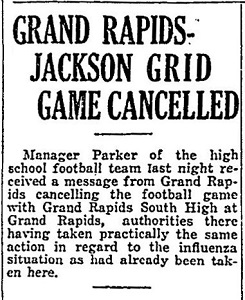 To the surprise of the world, a second war arrived in 1918. This one did not discriminate based on geographic or political borders. It would take more lives than World War I.
To the surprise of the world, a second war arrived in 1918. This one did not discriminate based on geographic or political borders. It would take more lives than World War I.
Globally, the Spanish Flu pandemic arrived in three waves, one in the spring, one in the fall of 1918, and a third arriving in the winter of 1919 and ending in the spring. It, too, would impact high school and college athletics in Michigan and beyond, as countless football games across the nation were cancelled in an attempt to help reduce the spread of the disease.
In the end, an estimated 675,000 would die in the United States from the virus. In Michigan, hundreds succumbed in October 1918 alone. In Detroit, between the beginning of October and the end of November, “there were 18,066 cases of influenza reported to Detroit’s Department of Health. Of these, 1,688 died from influenza or its complications.” Worldwide, an estimated 50 million were killed by the Influenza pandemic of 1918-1919.
 Ron Pesch has taken an active role in researching the history of MHSAA events since 1985 and began writing for MHSAA Finals programs in 1986, adding additional features and "flashbacks" in 1992. He inherited the title of MHSAA historian from the late Dick Kishpaugh following the 1993-94 school year, and resides in Muskegon. Contact him at [email protected] with ideas for historical articles.
Ron Pesch has taken an active role in researching the history of MHSAA events since 1985 and began writing for MHSAA Finals programs in 1986, adding additional features and "flashbacks" in 1992. He inherited the title of MHSAA historian from the late Dick Kishpaugh following the 1993-94 school year, and resides in Muskegon. Contact him at [email protected] with ideas for historical articles.
PHOTOS: (Top) The U.S. Department of Labor recruited high school students to work on farms as soldiers went oversees to fight World War I. (Middle top) A Working Reserve badge. (Middle) Lewis L. Forsythe. (Below) Another recruitment poster for the Working Reserve shows a man plowing a field while war rages in the background. (Photos collected by Ron Pesch.)
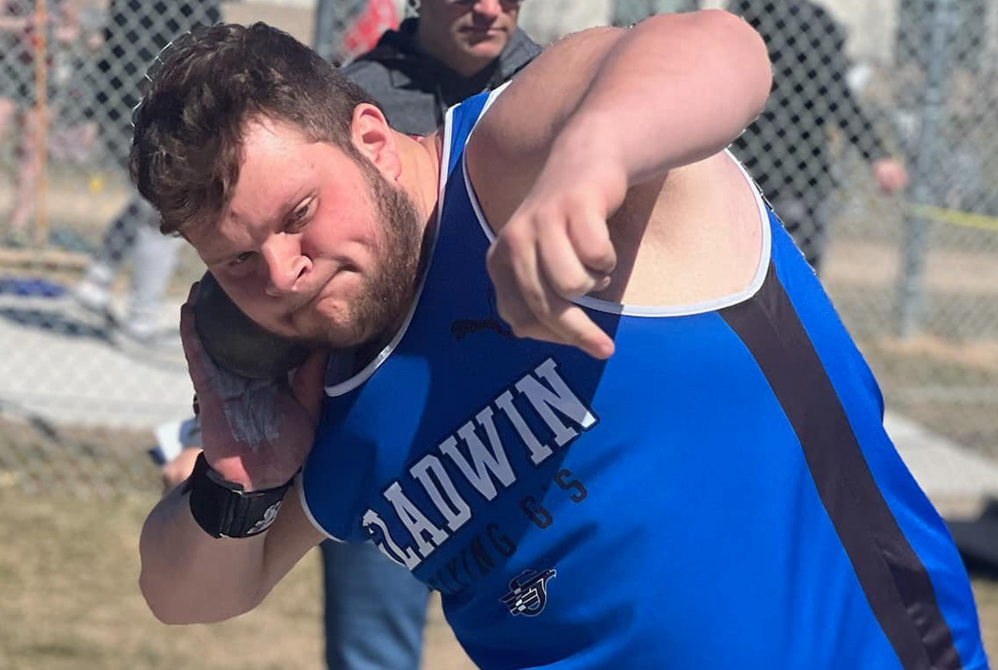
Goals Grow as Gladwin's Klein Seeks to Follow School Record with Big Finish
By
Paul Costanzo
Special for MHSAA.com
April 24, 2024
Logan Klein wanted to leave his mark on Gladwin athletics – and one could argue, as a starting offensive lineman on the 2022 Flying Gs football team which won the Division 5 title, he had already done that.
 But Klein was looking for more, so that spring, he switched from baseball to track & field, and went after it.
But Klein was looking for more, so that spring, he switched from baseball to track & field, and went after it.
“Really, I mean, I wanted a school record,” Klein said. “I had played baseball for freshman and sophomore year, and I knew I wasn’t getting it in baseball. I was good, but I wasn’t that good. I did (track & field) in seventh grade, and I was pretty good. I was really close in junior high (to school records) but then in eighth grade, we had COVID.”
In his first year back in the sport, Klein achieved his goal, setting the Gladwin school record in the shot put and throwing his way to a third-place, all-state finish at the 2023 Lower Peninsula Division 2 Finals.
Now, with a little more seasoning under his belt, he’s looking for even more.
“The big goal is to be a state champ,” he said. “The second goal, with how I’ve been throwing in the (discus) lately, I think I can be all-state in both events. That’s a really big one for me, too.”
Klein’s immediate success as a thrower didn’t come as a total surprise, as he really was quite good in seventh grade. He’s also a 6-foot-3, 270-pound athlete who, as mentioned, was a starter on a state championship-winning football team. The baseline was there.
He also had a willing teacher in teammate Logan Kokotovich, a 2023 Gladwin graduate who was a captain and Klein’s teammate in football, and the Gs’ top thrower prior to Klein’s arrival.
“(Klein) threw in junior high and he was pretty good, and then last year he started off real strong,” Gladwin boys track coach Buddy Goldsworthy said. “After lots of work on just technique stuff, he realized all the things he was doing wrong, then he just started throwing 50 footers. One person that helped make a good transition was Logan Kokotovich – he was good at football, too, and good friends with Klein. He showed Klein how to do a couple things better.”
On May 5, 2023, at the Nike Trax Invite at Meridian, Klein first threw over 50 feet in competition. Five days later, at the Jack Pine Conference meet, Klein had his school record, throwing 51 feet, 9 inches, smashing the old mark of 50-5 set in 1988.
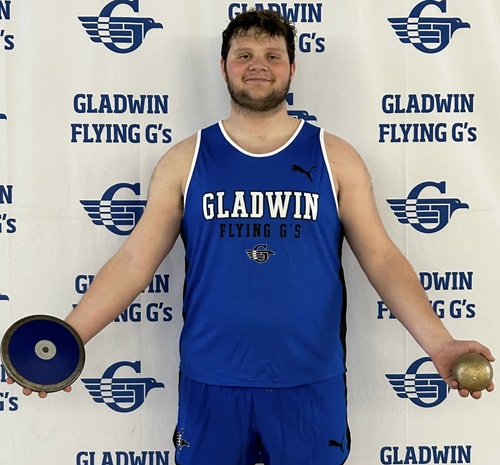 “I was starting to get up into the 50s, and I knew it was going to happen in the next meet,” he said. “I had been on a PR streak.”
“I was starting to get up into the 50s, and I knew it was going to happen in the next meet,” he said. “I had been on a PR streak.”
He broke it again in his next meet, the first of four times he has eclipsed his chart-topping mark – which now stands at 55-4¼.
“He’s a big, strong kid, and he loved throwing in junior high,” Goldsworthy said. “We knew that he could be that guy. Now, we didn’t know he would be that guy so quickly. That was a pleasant surprise for us. He loves throwing. He spent a lot of time during the summer saying, ‘Hey, can we go up and throw? Can I take a shot or disc home this weekend and just throw?’ ‘I know you’re going to be gone on vacation, but can I have a shot to work on throws?’ He’s a real student of the game.”
Klein said he’s fallen in love with throwing, and there is certainly a part of him that wishes he had started as a freshman, knowing the massive leap he’s taken in such a short amount of time.
But his being so new to the sport makes him a very intriguing prospect for college coaches, if he chooses to go that route. There has been some communication, but Klein hasn’t decided yet if wants to follow up on throwing at the next level or go into the workforce by becoming an electrician, something that is waiting for him if he wants it.
“I was definitely not planning on (throwing in college),” he said. “I was actually a four-year starter for football, so that’s what I thought I was going to do. I’ve only been doing this for two years now, and I definitely can grow a lot more. A couple colleges have talked to me, and that’s what they were saying, that I really have a lot more potential.”
While he mulls over that decision, he’s working toward reaching those end-of-year goals he’s set, and also bringing along the next wave of Gladwin throwers.
“We talk about it a lot,” Goldsworthy said. “You want to leave a legacy. If you’re a jerk, no one’s going to remember, or they’re going to remember you not in the ways you want. He’s really taken that to heart and he’s the person that people want to be around. He’s going to be remembered that, yeah, he threw 60 feet, but he helped (junior Jacob) Hurst, he helped (freshman Harvey) Grove, he helped (freshman Nick) Brasseur. They’ll remember, ‘We wouldn’t have been as good if we didn’t have Klein around.’”
Klein said coaching also is in his future, whether that’s next year as he starts his career, or later down the line if he chooses to go to college.
With his mark already firmly left on Gladwin athletics, he wants to make sure others can do the same.
“I just like seeing my teammates grow,” he said. “We’ve got a freshman right now that’s really good. I told him, ‘I don’t care if you beat my record. I just want to be there to coach you through it.’”
 Paul Costanzo served as a sportswriter at The Port Huron Times Herald from 2006-15, including three years as lead sportswriter, and prior to that as sports editor at the Hillsdale Daily News from 2005-06. He can be reached at [email protected] with story ideas for Genesee, Lapeer, St. Clair, Sanilac, Huron, Tuscola, Saginaw, Bay, Arenac, Midland and Gladwin counties.
Paul Costanzo served as a sportswriter at The Port Huron Times Herald from 2006-15, including three years as lead sportswriter, and prior to that as sports editor at the Hillsdale Daily News from 2005-06. He can be reached at [email protected] with story ideas for Genesee, Lapeer, St. Clair, Sanilac, Huron, Tuscola, Saginaw, Bay, Arenac, Midland and Gladwin counties.
PHOTOS (Top) Gladwin’s Logan Klein prepares to launch during a turn in the shot put circle. (Middle) Klein has high aspirations in both the shot and discus this spring. (Photos courtesy of the Gladwin athletic department.)

